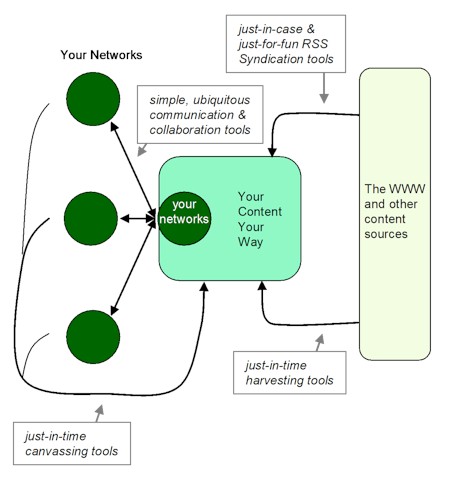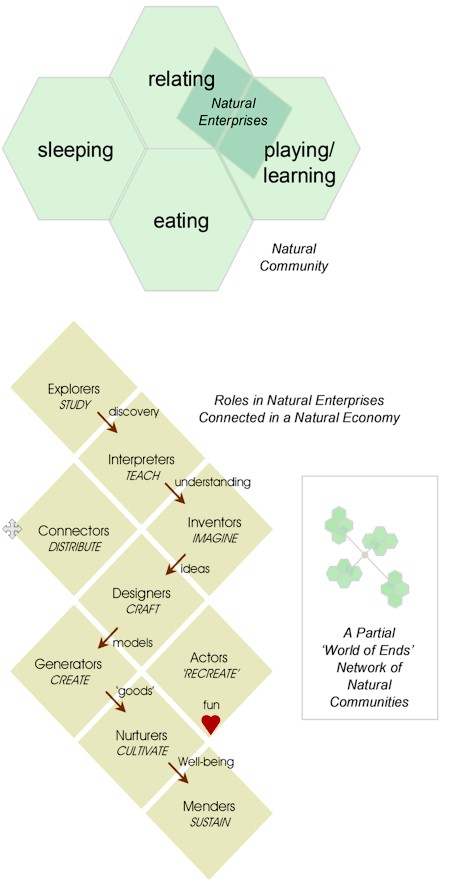 I‘m trying to understand why social networking applications (and to some extent online research) are still not getting much mainstream traction in organizations. The vast majority of SNA use, it seems, is for personal purposes, or by technology geeks. Meanwhile, researchers and buyers of external databases continue to lament the underutilization of their skills and resources. Recently I devised what I called Pollard’s Law for communication and collaboration tools (“they have to be simple and ubiquitous and meet an urgent need, or they won’t be used”). But what about the other types of SNAs and research applications — the ones focused on collection rather than connection?
Marshall McLuhan famously said that all technologies are extensions of the organs of the human body, to compensate for our bodies’ inherent limitations. So for example the automobile is an extension of our legs (giving us more speed and endurance), and the telescope is an extension of our eyes (giving us more acuity and reach). The personal computer, he predicted (it was still in its infancy when he was alive) would be an extension of our brains — our thinking processes, memory, and social networks.
Humans, at least modern ones, have a predilection for wanting to own, rather than share, such bodily extensions, so they are available precisely when, where and how we choose to use them. In the workplace, too, people want their own stuff — their own phones, offices, PCs etc., even when they may be unnecessary to the effective performance of their jobs. So perhaps it is not surprising that we want the information that we get in the workplace, our way, in our own space, organized in the way it makes sense to us. We resent getting sent information (e-mail and snail mail and by telemarketers) that we did not ask for and do not want.
If you look at the vast majority of websites on the Internet, and most of the social networking applications that are content-rich (weblogs, libraries and databases, news pages and feeds, public weblogs, ‘groupware’ etc.), you’ll find that their content has been put out there by its author or webmaster just in case it is of interest to others. Some of it is filtered, specialized and intended for specific communities (meant for you to browse, if you’re a member of one of those communities). The rest of it is unspecific, general or uncategorized (meant for you to search). Most of us browse only when we have the luxury of time to do so, and search only when we can’t find what we’re looking for more easily by just asking someone.
This content is not served up our way. For the most part, you cannot easily save it in a format that is easy to retrieve, change, annotate or otherwise ‘make your own’ (though many SNAs have been developed to try to let you do this, awkwardly). If you participate in an online forum or post comments to someone’s weblog, you will probably not recall what you said or where you posted it — it’s lost from your ‘extended memory’. Try to track all the interesting stuff you stumble on and you’ll end up with huge blogrolls and bookmark folders that are utterly unmanageable, and you still won’t be able to find what you’re looking for, even with Google Desktop, without a tedious search.
Consider the analogy of our transportation network, which, like online networks and technologies, enables us to meet with people and to find stuff we’re interested in. Imagine if the transportation system was so complicated that we gave up trying to meet with some people because we just couldn’t master the technology, or imagine the technology was so unwieldy that we couldn’t actually use it to take home most of the stuff we bought — every time we wanted to use it, we’d have to get back on the system and go out and use it at the store, and then return home.
Perhaps that analogy is stretching it a bit, but given the power of technology, why shouldn’t we have all the information we want, organized the way we want it, in our virtual ‘home space’, and why shouldn’t we be able to ‘bring additional stuff home’ and put it precisely where we want it? This awkwardness is, I believe, a key reason why so many are averse to using information on the Internet and averse to using content-focused SNAs. It will take a change in focus from content-provider to user-need, to overcome this.
The following table shows what I think is the average organizational user’s perception of the value of today’s main communication, collaboration and content-‘delivering’ applications:
* content is delivered in context ** great for the author, not so useful for the reader This is not to say SNAs like blogs, wikis, desktop videoconferencing and groupware are not useful — just that they will not become mainstream in organizations until they become easier to use, ubiquitous and/or provide information content in a format that lets individuals save it in their own ‘space’ their way.
I would give Facebook and MySpace the same scores as Weblogs, and predict that this type of structured personal page will not make headway in most organizations either. This table also explains why people are deluged with too many e-mails, phone calls, teleconferences and meetings in most organizations. These methods get the highest scores, but they are sub-optimal for many purposes. The problem is that the methods that work better just aren’t easy and ubiquitous and don’t give people the content they want their way.
Acceptance of these new technologies is exacerbated by security officers in many organizations who actively (and often unfairly or arbitrarily) discourage their use. It’s also true that researchers in organizations tend to browse more (because it can provide better context, and because they often know where to look) than researchers outside (who often have to depend on hit-or-miss searches across the whole web), so technologies that depend on such broad searches are considered a last resort. The graphic at the top of this post depicts what I think the average organizational user would ideally like as an ‘extension of his/her brain, memory and social networks’. All of the content s/he wants would be in one physical (hard drive) or virtual ‘place’. That place would list all his/her networks with one-click connectivity to those networks and the people in them, using simple and ubiquitous communication and collaboration tools.
The remaining content would be ‘collected’ in three ways that are analogous to how our brain collects information:
The idea is that you would never have to go ‘out’ for information — it would all be ‘delivered’ in the format and according to the schedule that s/he chose — his/her way. This content could include his/her personal and collected files, messages, music and video, photos, bookmarks, weblogs, addresses and contacts — any stuff, both personal and professional, both authored and ‘adopted’ by him/her, that s/he wants at his/her fingertips. This ‘auxiliary memory’ would be completely portable: We expect people to take charge of their personal career and learning now, and it’s important that, subject to confidentiality requirements, people not be forced to give up information when they change jobs, any more than we expect them to forget what they learned in previous jobs. So, just as the most valuable communication and collaboration tools/media will be those that are simple and ubiquitous, the most valuable content-and-collection tools will be those that transfer and deliver information content the way the user wants it, direct to the user’s ‘home space’. Give it to ’em their way, and they’ll value it, use it, and make it their own. I think it’s possible that, with some practice at managing all this ‘stuff’, some kind of natural neural organizational structure might emerge. But all of this is a long way off. In the meantime we need to start to think about how the next generation of SNAs should be designed. And, in our experiments in the workplace with these tools, we need to be cognizant of how and why people like to use, or resist using, information and information technologies. Until we can improve the scorecard in the table above, we can expect the process of getting acceptance of SNAs in theworkplace to be slow going. Category: Social Networking/Blogs in Business
|
Navigation
Collapsniks
Albert Bates (US)
Andrew Nikiforuk (CA)
Brutus (US)
Carolyn Baker (US)*
Catherine Ingram (US)
Chris Hedges (US)
Dahr Jamail (US)
Dean Spillane-Walker (US)*
Derrick Jensen (US)
Dougald & Paul (IE/SE)*
Erik Michaels (US)
Gail Tverberg (US)
Guy McPherson (US)
Honest Sorcerer
Janaia & Robin (US)*
Jem Bendell (UK)
Mari Werner
Michael Dowd (US)*
Nate Hagens (US)
Paul Heft (US)*
Post Carbon Inst. (US)
Resilience (US)
Richard Heinberg (US)
Robert Jensen (US)
Roy Scranton (US)
Sam Mitchell (US)
Tim Morgan (UK)
Tim Watkins (UK)
Umair Haque (UK)
William Rees (CA)
XrayMike (AU)
Radical Non-Duality
Tony Parsons
Jim Newman
Tim Cliss
Andreas Müller
Kenneth Madden
Emerson Lim
Nancy Neithercut
Rosemarijn Roes
Frank McCaughey
Clare Cherikoff
Ere Parek, Izzy Cloke, Zabi AmaniEssential Reading
Archive by Category
My Bio, Contact Info, Signature Posts
About the Author (2023)
My Circles
E-mail me
--- My Best 200 Posts, 2003-22 by category, from newest to oldest ---
Collapse Watch:
Hope — On the Balance of Probabilities
The Caste War for the Dregs
Recuperation, Accommodation, Resilience
How Do We Teach the Critical Skills
Collapse Not Apocalypse
Effective Activism
'Making Sense of the World' Reading List
Notes From the Rising Dark
What is Exponential Decay
Collapse: Slowly Then Suddenly
Slouching Towards Bethlehem
Making Sense of Who We Are
What Would Net-Zero Emissions Look Like?
Post Collapse with Michael Dowd (video)
Why Economic Collapse Will Precede Climate Collapse
Being Adaptable: A Reminder List
A Culture of Fear
What Will It Take?
A Future Without Us
Dean Walker Interview (video)
The Mushroom at the End of the World
What Would It Take To Live Sustainably?
The New Political Map (Poster)
Beyond Belief
Complexity and Collapse
Requiem for a Species
Civilization Disease
What a Desolated Earth Looks Like
If We Had a Better Story...
Giving Up on Environmentalism
The Hard Part is Finding People Who Care
Going Vegan
The Dark & Gathering Sameness of the World
The End of Philosophy
A Short History of Progress
The Boiling Frog
Our Culture / Ourselves:
A CoVid-19 Recap
What It Means to be Human
A Culture Built on Wrong Models
Understanding Conservatives
Our Unique Capacity for Hatred
Not Meant to Govern Each Other
The Humanist Trap
Credulous
Amazing What People Get Used To
My Reluctant Misanthropy
The Dawn of Everything
Species Shame
Why Misinformation Doesn't Work
The Lab-Leak Hypothesis
The Right to Die
CoVid-19: Go for Zero
Pollard's Laws
On Caste
The Process of Self-Organization
The Tragic Spread of Misinformation
A Better Way to Work
The Needs of the Moment
Ask Yourself This
What to Believe Now?
Rogue Primate
Conversation & Silence
The Language of Our Eyes
True Story
May I Ask a Question?
Cultural Acedia: When We Can No Longer Care
Useless Advice
Several Short Sentences About Learning
Why I Don't Want to Hear Your Story
A Harvest of Myths
The Qualities of a Great Story
The Trouble With Stories
A Model of Identity & Community
Not Ready to Do What's Needed
A Culture of Dependence
So What's Next
Ten Things to Do When You're Feeling Hopeless
No Use to the World Broken
Living in Another World
Does Language Restrict What We Can Think?
The Value of Conversation Manifesto Nobody Knows Anything
If I Only Had 37 Days
The Only Life We Know
A Long Way Down
No Noble Savages
Figments of Reality
Too Far Ahead
Learning From Nature
The Rogue Animal
How the World Really Works:
Making Sense of Scents
An Age of Wonder
The Truth About Ukraine
Navigating Complexity
The Supply Chain Problem
The Promise of Dialogue
Too Dumb to Take Care of Ourselves
Extinction Capitalism
Homeless
Republicans Slide Into Fascism
All the Things I Was Wrong About
Several Short Sentences About Sharks
How Change Happens
What's the Best Possible Outcome?
The Perpetual Growth Machine
We Make Zero
How Long We've Been Around (graphic)
If You Wanted to Sabotage the Elections
Collective Intelligence & Complexity
Ten Things I Wish I'd Learned Earlier
The Problem With Systems
Against Hope (Video)
The Admission of Necessary Ignorance
Several Short Sentences About Jellyfish
Loren Eiseley, in Verse
A Synopsis of 'Finding the Sweet Spot'
Learning from Indigenous Cultures
The Gift Economy
The Job of the Media
The Wal-Mart Dilemma
The Illusion of the Separate Self, and Free Will:
No Free Will, No Freedom
The Other Side of 'No Me'
This Body Takes Me For a Walk
The Only One Who Really Knew Me
No Free Will — Fightin' Words
The Paradox of the Self
A Radical Non-Duality FAQ
What We Think We Know
Bark Bark Bark Bark Bark Bark Bark
Healing From Ourselves
The Entanglement Hypothesis
Nothing Needs to Happen
Nothing to Say About This
What I Wanted to Believe
A Continuous Reassemblage of Meaning
No Choice But to Misbehave
What's Apparently Happening
A Different Kind of Animal
Happy Now?
This Creature
Did Early Humans Have Selves?
Nothing On Offer Here
Even Simpler and More Hopeless Than That
Glimpses
How Our Bodies Sense the World
Fragments
What Happens in Vagus
We Have No Choice
Never Comfortable in the Skin of Self
Letting Go of the Story of Me
All There Is, Is This
A Theory of No Mind
Creative Works:
Mindful Wanderings (Reflections) (Archive)
A Prayer to No One
Frogs' Hollow (Short Story)
We Do What We Do (Poem)
Negative Assertions (Poem)
Reminder (Short Story)
A Canadian Sorry (Satire)
Under No Illusions (Short Story)
The Ever-Stranger (Poem)
The Fortune Teller (Short Story)
Non-Duality Dude (Play)
Your Self: An Owner's Manual (Satire)
All the Things I Thought I Knew (Short Story)
On the Shoulders of Giants (Short Story)
Improv (Poem)
Calling the Cage Freedom (Short Story)
Rune (Poem)
Only This (Poem)
The Other Extinction (Short Story)
Invisible (Poem)
Disruption (Short Story)
A Thought-Less Experiment (Poem)
Speaking Grosbeak (Short Story)
The Only Way There (Short Story)
The Wild Man (Short Story)
Flywheel (Short Story)
The Opposite of Presence (Satire)
How to Make Love Last (Poem)
The Horses' Bodies (Poem)
Enough (Lament)
Distracted (Short Story)
Worse, Still (Poem)
Conjurer (Satire)
A Conversation (Short Story)
Farewell to Albion (Poem)
My Other Sites









 A day late for Father’s Day, this article is a tribute to my father. Life has not been terribly fair to him, but he greets every challenge he has faced with equanimity and grace, and he is kind and generous to a fault. He taught me to think for myself, and then to fight for what I believe in, no matter what. I just hope I will be able to pass on a fraction of the wisdom to others that he has. He has always been, and remains today, my role model, my intellectual foil, and my inspiration. Take a bow, Dad.
A day late for Father’s Day, this article is a tribute to my father. Life has not been terribly fair to him, but he greets every challenge he has faced with equanimity and grace, and he is kind and generous to a fault. He taught me to think for myself, and then to fight for what I believe in, no matter what. I just hope I will be able to pass on a fraction of the wisdom to others that he has. He has always been, and remains today, my role model, my intellectual foil, and my inspiration. Take a bow, Dad.



